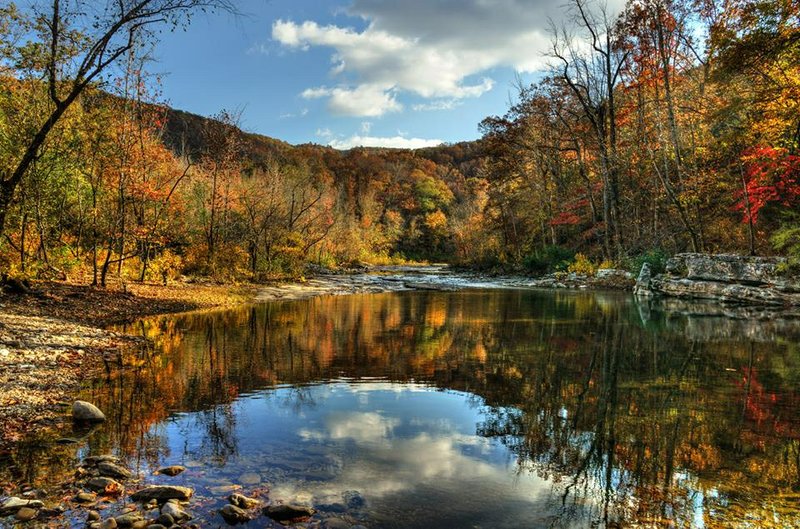A committee of lawmakers Tuesday skipped making a recommendation to the Legislative Council on a request by Gov. Asa Hutchinson to transfer $1 million to the state Department of Agriculture to support grants and projects within the Buffalo National River watershed.
At the behest of Sen. Terry Rice, R-Waldron, the council's Performance Evaluation and Expenditure Review Committee forwarded the Republican governor's request to the Legislative Council without suggesting that the council approve or reject the transfer of so-called rainy-day funds.
This way, there will be more lawmakers on hand for further discussion during Friday's council meeting because the Legislative Council has more members, Rice said before the committee approved his motion in a voice vote.
In a letter dated Oct. 1 to the Legislative Council's co-chairmen, Hutchinson said these rainy-day funds "will be used to support grants and projects within the Buffalo River Watershed, including but not limited to the following -- voluntary best management practices for farmers and land owners, improvements to wastewater and septic systems for cities and counties within the watershed, and reduction of sediment runoff from unpaved roads within the watershed."
The newly formed Buffalo River Conservation Committee and its subcommittees will identify projects and distribute funds with the aim of improving water quality and promoting conservation practices, the governor wrote in his letter to the co-chairmen, Sen. Cecile Bledsoe, R-Rogers, and Rep. Jeff Wardlaw, R-Hermitage.
The Nature Conservancy and the Buffalo River Foundation also have collectively pledged $1 million toward the Buffalo River Conservation Committee.
Hutchinson's creation of the conservation committee last month is the latest endeavor from his office regarding the Buffalo River, which has been the subject of heated political debate in recent years on how best to protect it.
During Tuesday's meeting, Rice referred to the governor's letter and said that because of what happened in the C&H Hog Farms case, "we have got a lot of young ag people that are concerned about their future that they may become litigants in their livelihood simply doing what they know as the best practices."
In the C&H Hog Farms case, "this Legislature agreed to, and I supported, a buyout of a private business that had no violations, that technically had not done anything wrong," he said. Doing that has "raised concerns with a lot of people."
Rice asked state Budget Administrator Jake Bleed to elaborate on the funding request.
"This is an opportunity, we hope, for folks in the watershed to take advantage of the funding, which has been requested today to get ahead of some potential issues that might cause a water-quality problem later on down the road," Bleed said.
The intent of this program "is not to create litigation, obviously," he said. "It is not to create regulations. It is not to impose anything on anybody."
But Rice told Bleed, "You understand the reason for concerns throughout this process. It's not just one thing. It's the culmination of many things. I don't blame people being concerned about their future."
On June 21, the Legislative Council granted conditional authority to Bledsoe and Wardlaw to approve Hutchinson's request to use up to $6.2 million in state rainy-day funds to obtain a conservation easement to shut down the hog farm, which is in the Buffalo National River watershed.
But the council asked the co-chairmen to first be satisfied that the state has a first-lien position on the easement, meaning the state would be superior to any lien holder regarding the use of the land.
Hutchinson's assurances to Bledsoe and Wardlaw that his office is checking for any liens on the hog farm prompted the two to sign off on that funding request a few weeks later.
C&H Hog Farms will be paid at the closing of escrow when all its swine have been removed, and funds will be concurrently exchanged for a conservative easement, also held in escrow, said Department of Parks, Heritage and Tourism spokeswoman Melissa Whitfield after Tuesday's meeting.
C&H Hog Farms will be paid $6.2 million, plus interest and less escrow expenses, probably no earlier than January 2020, she said. The funds include $3.7 million from the rainy-day fund, $1.5 million from the department and $1 million from the Nature Conservancy, Whitfield said.
During Tuesday's meeting, Rice also raised concerns about the state buying land from the Nature Conservancy. He cited two such purchases in Garland County -- one in recent months and one in 2018.
He said he questioned state forestry officials recently about a $1.4 million purchase of 420 acres from the Nature Conservancy in the Hot Springs area and "was told [the purchase is] totally different and it doesn't have anything to do with" the Buffalo River Watershed situation.
"The timing of it was a concern to me," he said.
The Forestry Division bought 360.83 acres within the Hot Springs Recharge Area in Garland County from the Nature Conservancy in May 2018 for $822,000, Department of Agriculture Secretary Wes Ward said. That purchase used funds from the Arkansas Natural and Cultural Resources Council, he said.
Ward said the department's Forestry Division is purchasing 408.44 acres within the same area in Garland County from the Nature Conservancy using funds from a U.S. Department of Agriculture Forest Legacy grant.
The expected price is $1,459,180, he said.
Both items are associated with preserving the Hot Springs Recharge Area, he said.
"All properties acquired in the Hot Springs Recharge Area are voluntary purchases with willing buyers and willing sellers," Ward said in a written statement. "No funds used within the Hot Springs Recharge Area have been used within the Buffalo River Watershed."
Metro on 10/16/2019
